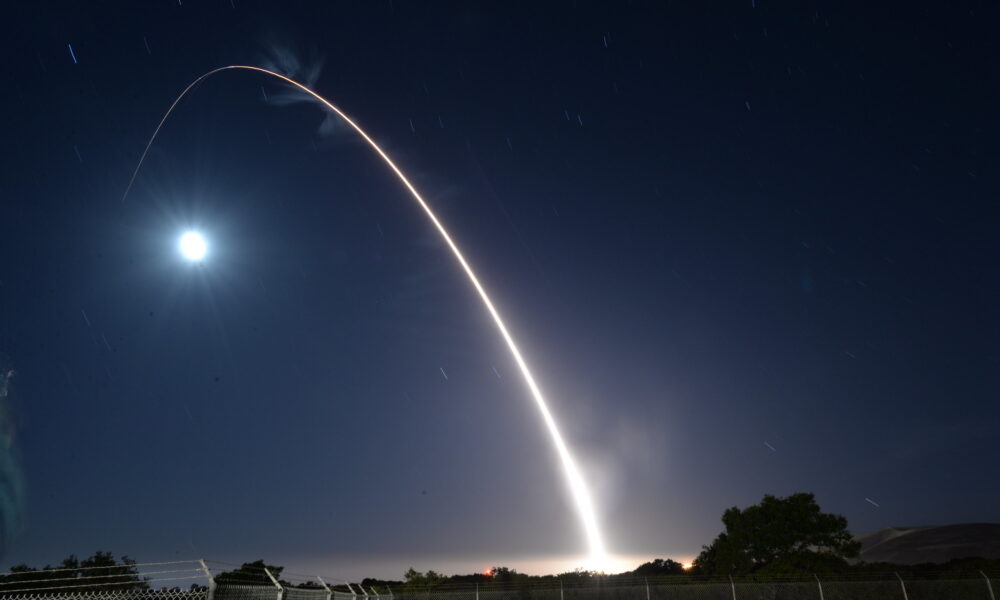On what had previously been a normal day, early warning alerts sound in an Alaskan military base: A nuclear missile has been detected over the Pacific Ocean. No one can be sure where it was launched, but the missile’s trajectory means it will strike the central United States in less than 20 minutes, putting millions of lives at risk. This is the premise of the new Kathryn Bigelow film A House of Dynamite, a political thriller that follows civilian and military leaders suddenly thrust into an Armageddon they’ve rehearsed countless times—except this time it’s real.
A House of Dynamite is required viewing for anyone who wants to understand the systemic risks—and the human stakes—of the nuclear weapons complex. The film comes to Netflix on October 24 following its US cinematic release on October 10. Before you watch, here are five things to know.
1. The United States has detected a nuclear attack before.
No country has ever launched a nuclear missile at the United States, but there have been several false alarms that convinced US leaders nuclear war was imminent. In 1960, early warning radar systems reported dozens of Soviet missiles flying towards the United States. What the systems had actually detected was the moon rising over Norway. In another incident, in 1979, US Strategic Air Command received information about a large-scale nuclear strike initiated by the Soviet Union. The source of this information was a training scenario tape that had mistakenly been transmitted as a real alert.
Both the United States and Russia have early warning systems that rely on both technology and human judgment. The aim of these systems is to detect a surprise nuclear attack in time to give decision makers the opportunity to respond. But such complex systems will always be vulnerable to technical and human mistakes.
Fortunately, the false alarms of the past were discovered before catastrophic and irreversible decisions were made. Unfortunately, that has too often come down to luck.
2. There might be only minutes to respond.
In A House of Dynamite, leaders are informed that a missile will strike the United States in less than 20 minutes (significantly shorter than the film’s almost two-hour run time, which explores multiple concurrent perspectives during the decision making window). Intercontinental ballistic missiles, which carry strategic nuclear warheads, can travel 30 times faster than the speed of a jet. That means a missile launched from Russia to the United States—or vice versa—could strike its target in the span of a lunch break. The speed at which a nuclear crisis can develop puts enormous pressure on every aspect of decision making.
US nuclear warheads are carried on three different vehicles: submarine-launched missiles, bombers, and land-based intercontinental ballistic missiles (ICBMs). Submarines are mobile and hidden in the ocean, while bombers can take to the skies during times of heightened readiness. By comparison, the intercontinental ballistic missiles in silos across the United States are sitting ducks.
If the missiles vulnerable in US silos are suspected of being targeted, it creates additional pressure on leaders to launch them as soon as they get warning of a strike, rather than waiting to get further information. To enable this, the United States keeps its ICBMs on “hair-trigger” alert, ready to be launched within minutes. The resulting “use-it-or-lose-it” dynamic is extremely dangerous, increasing the risks that a mistake or misjudgment could quickly lead to nuclear war.
3. Only one person would decide what happens next (and it isn’t Idris Elba).
A House of Dynamite shows how different political and military leaders grapple with the knowledge of an incoming catastrophe. Each person is trying to do their job with little information, less time, and impossibly high stakes. The film invites us to ask how decision making could be affected by these conditions as people disagree on the right course of action. But at the end of the day, the most consequential decisions all come down to a single person’s judgment.
In the United States, the use of nuclear weapons requires the authorization of the president (played in A House of Dynamite by Idris Elba). In a situation like that in the film, where it is believed the United States is under attack, the Pentagon would present the president with different options, including retaliation with nuclear weapons. The president is not required to consult with any advisors before issuing a launch order.
4. Missile defense can’t save us from nuclear war.
Over the last six decades, the United States has invested nearly $400 billion in the pursuit of missile defense, most of it on systems designed to defend against nuclear-armed ICBMs. It’s understandable that people long for technology to rescue us from the terrifying existential threat of nuclear war. But sadly, missile defense has always been a fantasy, not a solution to nuclear vulnerability.
The task of missile defense is described in A House of Dynamite as “hitting a bullet with a bullet.” Existing nuclear missile defense systems often fail even with ideal conditions during highly simplified tests, and that is against only a single target. In contrast, a realistic attack scenario could involve hundreds or even thousands of missiles. Simple and cheap countermeasures, such as decoy missiles, tip the balance even further in favor of an attacker.
Even after so much wasted time and money, the allure of a silver bullet is strong. Many US politicians still prefer to chase a miracle over facing hard realities—and the even harder work it will take to create a safe, sustainable world. Missile defense is a distraction and a detriment to that work. It gives leaders false hope and false confidence, encouraging dangerous choices, and it gives others the incentive to develop even more weapons and capabilities.
5. We have to save ourselves.
A House of Dynamite pulls back the curtain on the rigid, secretive system that operates around us every day. It is a system prepared at any moment to conduct a nuclear war. Our leaders ask us to place unwarranted faith in that system to keep us safe. But our world is incredibly fragile. Even when the system is operating exactly like it is designed, even when—as in the movie—our leaders do “everything right,” it cannot protect us from nuclear war. No matter how much we prepare, no matter how much money we invest, no matter how many weapons we have, we will always be vulnerable as long as we rely on a system that threatens catastrophic destruction for our security. Humanity cannot coexist with nuclear weapons forever.
Nothing is coming to our rescue. Most of our leaders ignore these problems or double down on the idea that nuclear weapons can keep us safe, building more weapons or hiding behind imaginary shields. But no matter how high or thick you build your walls, a house of dynamite can always be destroyed with a single match.
Survival comes down to this: We can surrender, we can despair, or we can dismantle the system that promises mass annihilation. You can take action with the Union of Concerned Scientists and our partners to dismantle this house of dynamite. We are calling on Congress to stop dangerous and unnecessary plans to carry out the most expensive expansion of the US nuclear weapons complex in history, including making hundreds of new plutonium “pits”—the explosive cores for new nuclear weapons.

